Pierre Auger Observatory

Cosmic Rays
The Earth is exposed to a continuous flux of high-energy particles, called cosmic rays. Sources of such radiation are, among others, the sun (at low energies) and supernova remnants (at intermediate energy scales). With an abundance of about one particle per $\text{km}^2$ and year also extremely high energetic particles with energies beyond $10^{18}$ eV can be found among the cosmic rays. These are the most energetic particles that can be found in the Universe! Their origin is still unknown: could they possibly be produced by supermassive black holes, which can be found in the centres of active galaxies? Are they messengers of still unknown processes of new physics?
Extensive Air Showers
Because of their low flux, particles at the highest energies can only be measured indirectly through the particle cascades (extensive air showers) which they produce in the atmosphere. Within such an air shower, billions of secondary particles are produced, propagating towards the ground where they can be detected with suitable devices
Pierre Auger Observatory
Our working group is a member of the Pierre Auger Collaboration. The Pierre Auger Observatory near the city of Malargüe, Argentina, is the world's largest device for measuring these air showers. It covers an area of more than 3000 $\text{km}^2$ with about 1660 detector stations. In addition, 27 fluorescence telescopes measure the fluorescence light, a faint afterglow in the air, induced by air showers. Complementing these instruments, the Observatory also features a large-scale radio detection array—originally developed as AERA and now extended as part of AugerPrime—to measure the radio emission from extensive air showers. This pioneering technique enables precise studies of shower geometry and composition with high duty cycle, and is actively developed with contributions from our group in Siegen. The Pierre Auger Observatory is a large-scale international project operated by about 400 scientists from 18 nations.
Fields of activity of the Siegen working group:
- Search for ultra-high-energy photons
- Multimessenger astronomy of astrophysical transient sources
- Mass composition of cosmic rays
- Studying possible deviations from Lorentz invariance using air showers
- Radio-interferometric air shower detection
- Geophysical processes of particle acceleration





